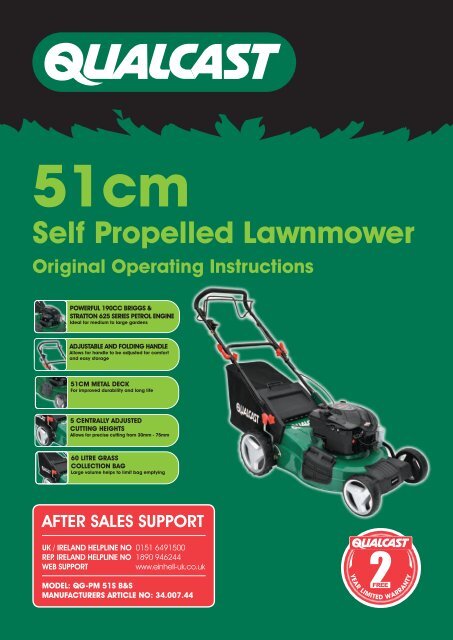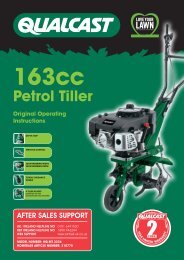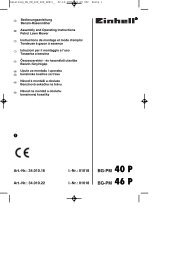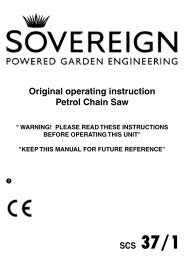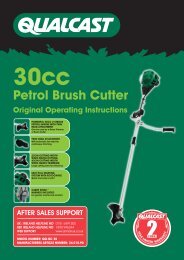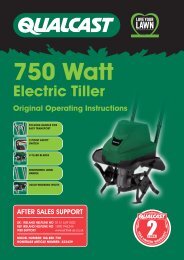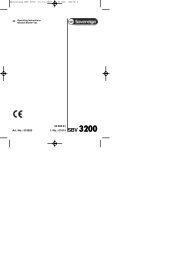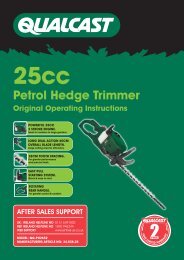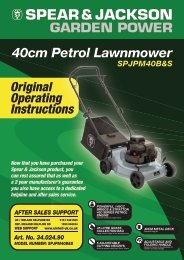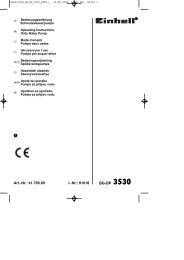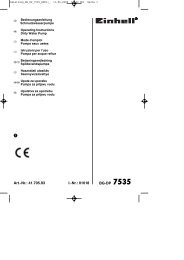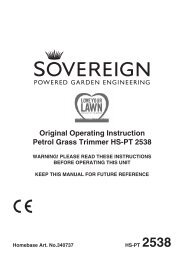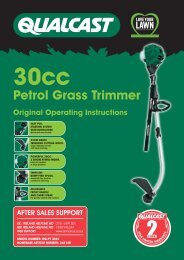51cm Self Propelled Lawnmower Original Operating ... - Einhell
51cm Self Propelled Lawnmower Original Operating ... - Einhell
51cm Self Propelled Lawnmower Original Operating ... - Einhell
- No tags were found...
You also want an ePaper? Increase the reach of your titles
YUMPU automatically turns print PDFs into web optimized ePapers that Google loves.
5a5b5c5d215e62006Helpline No. UK 0151 649 1500 / IRE 189 094 6244
Maintenance and storage1. Make sure that all nuts, bolts and screws aretightened securely and that the machine is insafe working condition.2. Never store the mower (with petrol in thetank) inside a building in which petrolfumes could come into contact with openflames or sparks.3. Allow the motor to cool before you put thelawn mower in an enclosed area.4. In order to avoid fire hazards, keep the engine,exhaust and the area around the fuel tank freefrom grass, leaves and leaking grease (oil).5. Routinely check the collection bag for signs ofwear and impaired functionality.6. For your own safety, replace worn or damagedparts without delay.7. If the fuel tank should require emptying thisshould only be done in the open air where it isadvisable to use a petrol suction pump(available from <strong>Einhell</strong> UK - call 0151 649 1500).CAUTION!Read all safety regulations and instructions.Any errors made in following the safety regulationsand instructions may result in an electric shock,fire and/or serious injury.Keep all safety regulations and instructions in asafe place for future use.Explanation of the symbols on the machine(Fig. 11):1) Read the operating instructions2) Important! Danger from catapulted parts.Keep a safe distance.3) Important! Switch off the engine and pull thespark plug boot before doing any maintenance,repair, cleaning or adjustment work.4) Fill with oil and fuel before starting the mower.5) Caution! Wear ear protection andsafety goggles.6) Engine start/stop lever (I=Engine on; 0=Engine off)7) Drive lever (clutch lever)2. Layout (Fig. 1+2)1. Engine start/stop lever – engine brake2. Top push bar3. Throttle lever4. Starter cable5. Lower push bar6. Grass collection bag7. Ejector flap8. Cutting height adjustment9. Tank filler cap10. Oil-filler neck11. Oil drainage screw12. 2 x cable ties13. Spark plug wrench14. 2 x square head screws for top push bar15. 2 lever cam screws for upper push barwith high speed clamping function16. Side ejector cover17. 4 x star knobs for push bar18. Drive lever (clutch lever)19. Drive wheel (left and right)20. Side ejector adaptor21. Mulching adaptor22. Cover for lower push barHelpline No. UK 0151 649 1500 / IRE 189 094 624409
3. Proper operationThe petrol lawn mower is intended for private usei.e. for use in home and gardening environments.Private use of the lawn mower refers an annualoperating time generally not exceeding that of50 hours, during which time the machine isprimarily used to maintain small-scale, residentiallawns and home/hobby gardens. Public facilities,sporting halls, and agricultural/forestry applicationsare excluded.Please note that our equipment has notbeen designed for use in commercial, tradeor industrial applications. Our warranty willbe voided if the machine is used incommercial, trade or industrial businessesor for equivalent purposes.The operating instructions as supplied by themanufacturer must be kept and referred to inorder to ensure that the lawn mower is properlyused and maintained. The instructions containvaluable information on operating, maintenanceand servicing conditions.Important! Due to the high risk of bodily injury tothe user, the lawn mower may not be used to trimbushes, hedges or shrubs, to cut scalingvegetation, planted roofs, or balcony-growngrass, to clean (suck up) dirt and debris offwalkways, or to chop up tree or hedge clippings.Moreover, the lawn mower may not be used as apower cultivator to level out high areas such asmolehills.For safety reasons, the lawn mower may not beused as a drive unit for other work tools or toolkitsof any kind.4. Technical dataNote: The enclosed manual from Briggs &Stratton provides detailed technical dataon the engine!Engine type:Single cylinder four-stroke engine, 190 ccmWorking speed: 2800 min -1Fuel:standard petrolCutting height adjustment: central, (30-75 mm)Cutting width:510 mmL pA sound pressure level:87.8 dB(A)L WA sound power level:98 dB(A)Uncertainty measurement:2dBVibration a hw 6.36 m/s 2Uncertainty measurement:1,5m/sWeight: (without oil)40.7 kg5. Before starting the equipment5.1 Assembling the componentsSome parts of the lawnmower need to beassembled. For quick and easy assembly, readand follow the instructions below.Important! You will need the following additionaltools (not supplied) for assembly, and also formaintenance work:• A flat oil drip tray (for changing the oil)• A 1 litre measuring jug (oil/petrol resistant)• A petrol can• A funnel (suitable for the tank’s petrol filler neck)• Household wipes (to wipe up oil/petrol residue;dispose of these at a filling station)• A petrol suction pump (plastic, available from<strong>Einhell</strong> UK Ltd - call 0151 649 1500(IRE 189 094 6244))• An oil can with hand pump (available from DIYstores)10Helpline No. UK 0151 649 1500 / IRE 189 094 6244
Assembly1. Take the mower and attachment parts outof the packaging and check that all parts arepresent (Fig. 2).2. Affix the lower push bar (Fig. 3a/Item 5) tothe mower housing and set the desiredworking height. 3 different working heights areavailable. Each peg on the lower push barcan be inserted into a hole situated directlyopposite to it, on the mower housing, forexample A-A (Fig. 3). The lower push bar mustbe equally adjusted on both sides. Now affixthe cover (Fig. 3a/Item 22) and attach thepush bar (5) using the square head screws (14)and the star knobs (17) as shown in Figure 3a.3. Fasten the top push bar to the bottom pushbar using a lever cam screw (Fig. 3b/Item 15)and a star knob (Fig. 3b/Item 17) on eachside. Make sure that the lobes of the levercam screws are folded towards the inside sothat the high speed clamping functionremains operational.4. Insert the grip of the starter cord (Fig. 3c/Item 4) into the hook provided for that purposeas shown in Figure 3c.5. Fasten the cords to the push bar with thesupplied cable ties (Fig. 3d/Item. 12).6. Lift the ejector flap (Fig. 4 / Item 7) with onehand and hook in the grass bag as shown inFigure 4.5.2 Setting the cutting heightImportant! Adjust the cutting height only whenthe engine is switched off and the plug boothas been pulled.- Before you begin to mow, check to ensurethat the blade is not blunt and that none ofthe fasteners are damaged. To prevent anyimbalance, replace blunt and/or damagedblades as a set only (if applicable). To carryout this check, first switch off the engine andpull the spark plug boot.- The cutting height is centrally adjusted withthe cutting height adjustor lever (Fig. 7/Item 8).Up to 5 different cutting heights can beselected.- Pull the adjustor lever out and select thedesired cutting height. The lever snaps into thedesired position.6. OperationNote: For detailed information on the engine& oil, refer to the enclosed manual fromBriggs & Stratton.Important. The engine does not come with oil init. Therefore, be sure to add oil before starting theengine. The oil level in the engine must bechecked each time before mowing (see theBriggs & Stratton manual). You will also need to fillthe fuel tank with petrol, as this is also not suppliedupon delivery.In order to avoid any unintentional start-ups of thelawn mower, it comes equipped with an enginebrake (Fig. 5a/Item 1) which must be pulled backbefore the engine can be started. When theengine control lever is released it must return to itsinitial position, at which point the engineautomatically switches off.You can control the rotation speed of the bladeusing the speed lever (Fig. 6).Before you start mowing, you should run throughthis operation several times in order to ensure thatthe machine is working properly.Whenever you need to perform any kind ofadjustment and/or repair work on your lawnmower, wait until the blade has come to acomplete stop.Always switch off the engine before carrying outany adjustments, maintenance or repairs.Note:1. Engine brake (Fig. 5a/Item 1): Use the lever tostop the engine. When you release the lever theengine and the blade stop automatically. Tomow, hold the lever in the working position (Fig.5b). Before you start to mow, check the start/stoplever several times to be sure that it is workingproperly. Ensure that the tension cable can besmoothly operated (i.e. is not catching or kinked inany way).Helpline No. UK 0151 649 1500 / IRE 189 094 624411
2. Speed lever (Fig. 6): Move this lever in order toincrease or decrease the engine speed.(Tortoise = Slow / Hare = = Fast).3. Drive lever (clutch lever) (Fig. 5a/Item 18): If youpress this (Fig. 5c) the clutch for the drive will beclosed and the lawnmower will start to move withthe motor running. Release the drive lever in goodtime to stop the moving lawnmower. Practicestarting and stopping before you use the mowerfor the first time until you are familiar withcontrolling the mower.4. Caution: The blade begins to rotate as soonas the engine is started.Important: Before you start the engine, move themotor brake several times to be sure that the stopcable is properly working. Note: The engine isfactory set to a speed that is optimal for cuttingand blowing grass into the collection bag and isdesigned to provide many years of use.5. Check the oil level.6. Fill the tank with petrol when it is empty, using afunnel and measuring vessel. Make sure that thepetrol is clean.Note: Use only unleaded petrol as fuel.Warning: Never use more than one safety petrolcan. Do not smoke when refueling. Switch off theengine before refueling and allow the engine tocool down for a few minutes.To Start the Engine7. Ensure that the ignition cable is connected tothe spark plug.8. Press the red primer button 5 times (Fig. 10).9. Move the speed lever to the Haresetting (Fig. 6).10. Stand behind the mower. Place one hand onthe engine start/stop lever and pull the barstogether (Fig. 5a Fig. 5b). Place the other handon the starter handle.11. Start the engine using the reversing starter(Fig.3c/Item 4). To do this pull the handleapprox.10 – 15 cm (until you feel a resistance)and then start the engine with a sharp pull. If theengine does not start, pull the handle again. Thiscould take up to 10 pulls.Important! Never allow the starter cord tosnap back.Note: In cold weather, it may be necessary torepeat the starting process several times.12. When the engine is at working temperature itcan be started in the Tortoise setting (Fig. 6).To start the mower moving forwardOnce the engine is running, operate the enginedrive; by pulling the Drive lever towards the toppush bar (Fig. 5c). Always walk behind thelawnmower whist the drive is working.To stop the mower moving forwardRelease the Drive lever away from the top pushbar (Fig. 5b). The engine will still be running & theblade will still be rotating.To stop the engine(Always try to release the Drive lever, beforestopping the engine). Release the engine start/stop lever (Fig. 5a). The Engine will stop running &the blade will stop rotating.MulchingIn the mulching mode the cuttings are shreddedin the enclosed mower housing and then spreadback onto the lawn. It is not necessary to gatherand dispose of the grass.Important: Mulching is only possible if the lawn isrelatively short. Optimum results can be achievedonly with a mulching blade (available as anaccessory).To use the mulching function, remove the grasscollection bag, slide the mulching adaptor intothe ejector opening (Fig. 5d/Item 20) and closethe ejector opening.Side ejectorYou should fit the mulching adaptor (Fig. 5d / Item21) in order to use the side ejector. Connect theside ejector adaptor (Fig. 5e/Item 18) as shown inFigure 5e.6.1 Before mowingImportant information1. Make sure that you are properly dressed whenmowing. Wear sturdy, non-slip footwear; do notwear sandals or tennis shoes.2. Inspect the blade. A blade that is bent ordamaged in any other way must be immediatelyexchanged for a genuine <strong>Einhell</strong> replacementblade.3. Do not fill the fuel tank indoors, but rather out in12Helpline No. UK 0151 649 1500 / IRE 189 094 6244
the open. Use a filling funnel and a measuringjug. Wipe off any spilled petrol.4. Read and follow the instructions in theoperating manual as well as the informationregarding the engine and accessory equipment.Store the manual in a place where it can bereadily accessed by other users of the machine.5. Exhaust gas is dangerous. Only start the engineout in the open.6. Make sure that all the guards are fitted andthat they are in good working order.7. The machine should only be operated bypersons who are well informed with the way itworks, and who are in reasonably good physicalcondition.8. It can be dangerous to mow the grass when itis wet. Try to ensure that you only mow the grasswhen it is dry.9. Advise children and others to keep well awayfrom the lawn mower.10. Never mow the grass in poor visibility.11. Remove all loose objects from the lawnbefore you start mowing the grass.6.2 Tips for proper mowingImportant! Never open the chute flap when thegrass collection bag has been detached (to beemptied) and the engine is still running. Therotating blade can cause serious injuries!Always carefully fasten the chute flap andcollection bag. Switch off the engine beforeemptying the collection bag.Always ensure that a safe distance (provided bythe length of the long handles) is maintainedbetween the user and the mower housing. Beespecially careful when mowing and changingdirection on slopes and inclines. Maintain a solidfooting and wear sturdy, non-slip footwear andlong trousers. Always mow along the incline (notup and down).For safety reasons, the lawn mower may not beused to mow inclines whose gradient exceeds 15degrees. Use special caution when backing upand pulling the lawn mower. Tripping hazard!6.3 MowingOnly use a sharp blade that is in good condition.This will prevent the grass blades from fraying andthe lawn from turning yellow.Try to mow in straight lines for a nice, clean look inin so doing, the mowing swaths should alwaysoverlap each other by a few centimeters in orderto avoid bare strips.Keep the underside of the mower housing cleanand remove grass build-up. Deposits not onlymake it more difficult to start the mower; theydecrease the quality of the cut and make itharder for the machine to bag the grass. Alwaysmow along inclines (not up and down). Slightlyturning the front wheels up the hill while mowingwill assist the mower in producing a straight line.Select the cutting height according to the lengthof the grass. If the lawn has grown quite a bit,mow over it several times so that no more than 4cm of grass are cut at one time.Switch off the engine before inspecting theblade. Keep in mind that the blade continuesto rotate for a few seconds after the enginehas been switched off. Never attempt tomanually stop the blade.Regularly check to see if the blade is securelyattached, is in good condition and is sharp. If thecontrary is the case, sharpen the blade orreplace it. In the event that the blade strikes anobject, immediately switch off the lawn mowerand wait for the blade to come to a completestop. Then inspect the condition of the blade andthe blade mount. Replace any parts that aredamaged.Tips for proper mowing:1. Pay attention to ensure that you do not run intoor over anything that could damage the mower.The lawn mower could be damaged and/or themachine could inflict bodily injury.2. A hot engine, exhaust or drive unit can burn theskin if touched. Thus, do not touch these partsunless the mower has been switched off for sometime and you know that they have cooled down!3. Use extra caution when mowing on inclinesand steep grades.4. Do not use the mower if the daylight or artificiallight levels are insufficient .5. Check the mower, the blade and other parts ifHelpline No. UK 0151 649 1500 / IRE 189 094 624413
they have struck a foreign object or if themachine vibrates more than usual.6. Do not make any adjustments or repairs untilthe engine has been switched off. Pull the plugboot off the spark plug.7. Pay special attention if you are mowing directlynext to a street or are close by one (traffic). Alwayskeep the grass chute pointed away from thestreet.8. Avoid mowing in places where the wheelshave trouble gripping or mowing is unsafe in anyother way. Before you back up, ensure thatnobody is standing behind you (especially littlechildren and pets who are more difficult to see).9. When mowing over thick, high grass, select thehighest cutting level and mow at a slower speed.Before you remove any grass or blockages of anykind, switch off the engine and pull the plug boot.10. Never remove any safety-related parts.11. Never fill the engine with petrol when it is hot oris running.6.4 Emptying the collection bagAs soon as grass clippings start to trail the lawnmower, it is time to empty the collection bag.Important! Before taking off the grass collectionbag, switch off the engine and wait until theblade has come to a stop.To take off the grass collection bag, use onehand to lift up the chute flap and the other tograb onto the grass collection bag handle (Fig.4). Remove the grass collection bag. For safetyreasons, the chute flap automatically fallsdown after removing the grass collection bagand closes off the rear chute opening. If anygrass remains in the opening, it will be easier torestart the engine if you pull the mower backapprox. 1 metre.Do not use your hands or feet to removeclippings in or on the mower housing, but insteaduse suitable tools such as a brush or a handbroom. Ensure that both the engine and theblade are stopped before attempting to removeclippings and debris.In order to ensure that the majority of grassclippings are picked up, the inside of both thecatch bag and especially the air grill must becleaned after each use.Re-attach the catch bag only when the engine isswitched off and the blade is stopped.Using one hand, lift up the chute flap, whilegrabbing onto the grass collection bag handlewith the other. Hook on the grass collection bagfrom the top. (see Fig. 4).6.5 After mowing1. Allow the engine to cool before you put thelawn mower in an enclosed area.2. Remove grass, foliage, grease and oil beforestoring the mower. Do not place any objects ontop of the mower.3. Check all the screws and nuts once morebefore you start to use the lawn mower again.Tighten any loose screws.4. Also be sure to empty the grass collection bag.5. Pull the spark plug boot to preventunauthorized use.6. Ensure that you do not park the mower next toany source of danger. Petrol fumes can lead toexplosions.7. Only original parts or parts approved by themanufacturer may be used for repairs (see c).8. If the lawn mower is not going to be used foran extended period, empty the petrol tank usinga petrol suction pump.9. Tell your children not to use the mower.It is not a toy.10. Never place petrol near an ignition source.Always use a can that is approved to store petrol.Keep petrol away from children.11. Oil and maintain the machine.7. Cleaning, maintenance, storage,transport and ordering of spare partsImportant: The enclosed engine manual fromBriggs & Stratton provides maintenanceinformation and maintenance intervalinformation on the engine.Important:Never work on or touch conducting parts on the14Helpline No. UK 0151 649 1500 / IRE 189 094 6244
ignition unit with the engine running. Always pullthe spark plug boot from the spark plug beforestarting any cleaning or maintenance. Neverperform any work on the machine while it isrunning. Any work not described in these<strong>Operating</strong> Instructions must be performed by anauthorized service workshop only.7.1 CleaningAfter each use, the mower should be thoroughlycleaned (especially the underside and bladereceptacle).Note: Before you tilt the lawnmower onto its side,empty the fuel tank completely with a petrolpump. The lawnmower must not be tilted morethan 90 degrees. The simplest time to remove dirtand grass is directly after mowing. Dried residualgrass and dirt could cause damage to themowing operation. Make sure the grass ejectorcanal is free from residual pieces of grass andremove these if necessary. Never clean themower with a direct jet of water or a high pressurecleaner. The motor must stay dry. Aggressivecleaning agents such as cold cleaning solvent orpetroleum ether must not be used.7.2 Maintenance7.2.1 Wheel axles and wheel hubsThese should be lightly greased once a season.To do so, remove the wheel caps with ascrewdriver and slacken the fastening screws onthe wheels.7.2.2 BladeFor safety reasons you should only ever have yourblade sharpened, balanced and mounted by aservice workshop. For optimum results it isrecommended that the blade should beinspected once a year.Changing the blade (Fig. 8)Only ever use original spare parts when havingthe blade replaced. The marking on the blademust be matched with the number given in thelist of spare parts. Never have any other model ofblade fitted.Damaged bladesShould the blade, in spite of all precautions,come into contact with an obstruction, shut downthe engine immediately and pull the spark plugboot. Tip the lawn mower onto its side and checkthe blade for damage. Damaged or bentblades must be replaced. Never attempt tobend a bent blade back to straight again. Nevermow the lawn with a bent or heavily worn bladeas this will cause vibrations and can lead to furtherdamage to the lawn mower.Important: There is a risk of injury if you work with adamaged blade.Resharpening the bladeThe blades can be resharpened with a metal file.In order to avoid imbalance, the blade should beresharpened by a service workshop.7.2.3 Care and adjustment of the cablesOil the cables at regular intervals and check thatthey move easily.7.2.4 RepairsAfter any repair or maintenance work, check thatall safety-related parts are in place and in properworking order.All parts which may cause injury must be keptwhere they are inaccessible to children or others.Important: In accordance with product liabilitylegislation we are not liable for any damagescaused by improper repairs or the use of spareparts that are not original spare parts or partsapproved by us. In addition, we are also not liablefor any damages arising from improper repairs.Such work should be performed by a customerservices workshop or authorized specialist. Thesame applies to accessory parts.7.2.5 Times of usePlease comply with statutory regulations, whichmay vary from location to location.7.3 Preparing the mower forlong-term storageCaution: Do not empty the petrol tank inenclosed areas, near fire or when smoking.Petrol fumes can cause explosions and fire.1. Empty the petrol tank with a petrolsuction pump.2. Start the engine and let it run until anyremaining petrol has been used up.3. Clean the cooling fins of the cylinderand the housing.Helpline No. UK 0151 649 1500 / IRE 189 094 624415
4. Be sure to clean the entire machine to protectthe paint.5. Store the machine in a well-ventilated place.IMPORTANT!7.4 Preparing the mower for transportation1. Empty the petrol tank (see item 7.3.1).2. Always let the engine run until it has used up theremainder of petrol in the tank.3. Empty the engine oil from the warm engine.4. Remove the spark plug boot from thespark plug.5. Clean the equipment.6. Remove the start tension cable from the hook(Fig. 3c). Slacken the wing nuts and fold down theupper push bar.7. Wedge a few layers of corrugated cardboardbetween the upper and lower push bars and theengine in order to prevent any chafing.7.5 Ordering replacement partsPlease quote the following data when orderingreplacement parts:• Type of machine QG-PM 51S B&S• Article number of the machine 34.007.44• Identification number of the machine 11010• Replacement part number of the part required8. Disposal and recyclingThe unit is supplied in packaging to prevent itsbeing damaged in transit. This packaging is rawmaterial and can therefore be reused or canbe returned to the raw material system.The unit and its accessories are made ofvarious types of material, such as metal andplastic. Defective components must bedisposed of as special waste. Ask your localcouncil for information.9. Faults and remedies for faultsCaution: Always switch off the engine and pullthe ignition cable before starting any inspection oradjustment work.Caution: If, after making an adjustment or repairto the engine, you let it run for a few minutes,remember that the exhaust and other parts willget hot. Thus, do not touch parts that emanateheat, as these may burn you.Important. If problems arise in connection withthe engine, please refer to the enclosed manualfrom Briggs & Stratton.FAULT POSSIBLE CAUSES REMEDYLoud while running, machinevibrates heavilyEngine does not start- Screws are loose- Blade fasteners are loose- Blade is unbalanced- Brake lever not pressed- Fuel tank is empty- Check screws- Check blade fasteners- Replace blade- Press brake lever- Refill with fuelMower does not drive forward - Drive Lever not pressed - Press Drive leverUneven mowing resultsUnsatisfactory bagging ofthe grass- Blade is blunt- Cutting height is too low- Engine speed is too low- Engine speed is too low- Cutting height is too low- Blade is worn- Basket is clogged- Sharpen the blade- Set correct height- Set lever to max.- Set speed lever to max.- Set correct height- Replace the blade- Empty the collection bag16Helpline No. UK 0151 649 1500 / IRE 189 094 6244
NotesHelpline No. UK 0151 649 1500 / IRE 189 094 624417


